Stack structure for laminated solid oxide fuel cell, laminated solid oxide fuel cell and manufacturing method
a technology of solid oxide fuel cell and stack structure, which is applied in the manufacture of cell components, final product manufacturing, electrochemical generators, etc., can solve the problems of more difficult construction of stack structure, reduce the internal resistance of solid electrolyte, reduce the thickness of solid electrolyte, and improve power generation characteristics
- Summary
- Abstract
- Description
- Claims
- Application Information
AI Technical Summary
Benefits of technology
Problems solved by technology
Method used
Image
Examples
example 1
[0089]In this example, Ni / 8YSZ cermet (Ni:8YSZ=80:20 (mole ratio)) was used for the fuel electrode, La0.8Sr0.2MnO3 (LSM) for the air electrode, 8YSZ for the electrolyte, and La0.79Ca0.06Sr0.15CrOx (LCaSCr) for the separator. Slurries of each were prepared, and the separator sheet and solid electrolyte sheet were prepared by tape casting as green sheets 20 μm to 80 μm thick. For the air electrode sheet, a 20 μm-thick green sheet was prepared having an air electrode material region with a seal material region consisting of separator material at one end. For the fuel electrode sheet, a 20 μm-thick green sheet was prepared having a fuel electrode region with a seal material region consisting of separator material at one end. The slurry concentrations were adjusted for each sheet to obtain uniform shrinkage of the green sheets during heat treatment.
[0090]These sheets were laminated as shown in FIG. 6, and fired in air at 1400° C. The resulting structure was integrated without warpage, re...
example 2
[0093]In this example, carbon paste was screen printed when laminating the separator sheet to the air electrode sheet and the separator sheet to the fuel electrode sheet in Example 1, and firing was performed as in Example 1. The resulting structure was shown to have spaces formed in the regions where carbon paste was applied, while still maintaining overall integrity as a structure. This shows that fine gas channels can be formed using an evaporative material.
example 3
[0094]In this example, LaCaSCr powder was compounded with 3YSZ (3 mole % yttrium-stabilized zirconia) in amounts of 1%, 2%, 3%, 4%, 5% and 7% of the mass of the oxide powder and roughly 10 mass % calcium nitrate in addition to these oxide powders, and mixed well in a mortar. This mixed powder was molded in a uniaxial press (1300 kgf / cm2, 5 minutes), and fired for 5 hours in atmosphere at 1300° C. A comparative example was also prepared by the same operations but with no 3YSZ added (sample with 0 mass % calcium nitrate-containing 3YSZ).
[0095]The volume and weight of the resulting sintered body were measured, and the density calculated. The results are shown in FIG. 8. FIG. 9 shows the results of scanning electron microscope (SEM) observation of cross-sections of the resulting sintered bodies (0 mass % and 1 mass % samples).
[0096]As shown in FIG. 8, the density of the lanthanum-calcium-strontium-chromium oxide, which was 5.3 g / cm3 without added 3YSZ, rose to 6% with 1 mass % 3YSZ adde...
PUM
| Property | Measurement | Unit |
|---|---|---|
| thicknesses | aaaaa | aaaaa |
| thicknesses | aaaaa | aaaaa |
| thickness | aaaaa | aaaaa |
Abstract
Description
Claims
Application Information
 Login to View More
Login to View More - R&D
- Intellectual Property
- Life Sciences
- Materials
- Tech Scout
- Unparalleled Data Quality
- Higher Quality Content
- 60% Fewer Hallucinations
Browse by: Latest US Patents, China's latest patents, Technical Efficacy Thesaurus, Application Domain, Technology Topic, Popular Technical Reports.
© 2025 PatSnap. All rights reserved.Legal|Privacy policy|Modern Slavery Act Transparency Statement|Sitemap|About US| Contact US: help@patsnap.com



